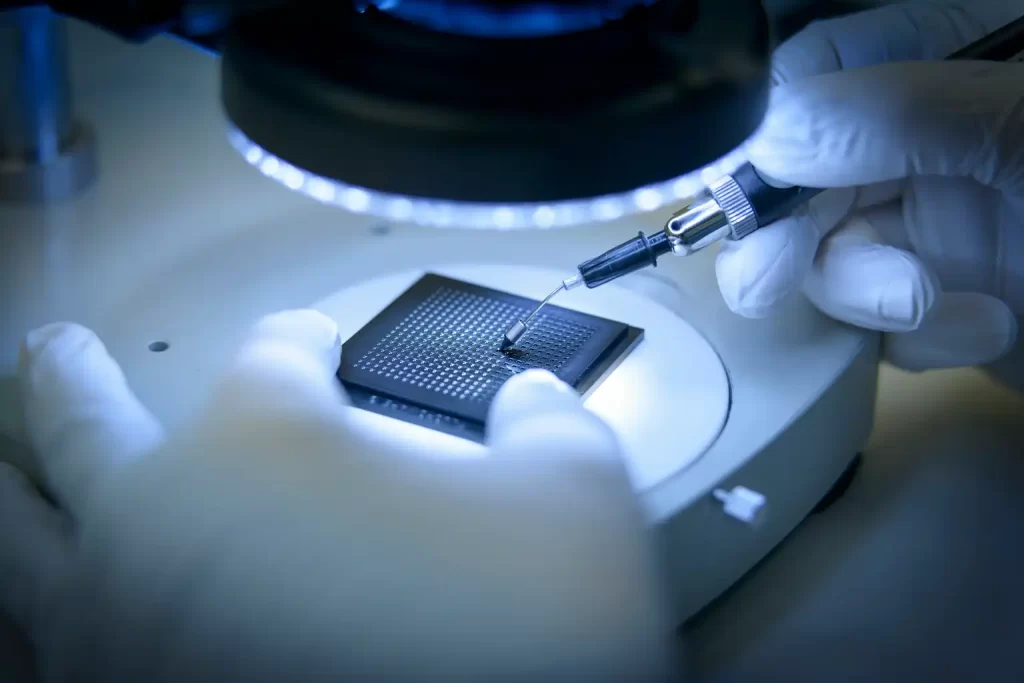You might’ve noticed how fabless chip designers are quietly transforming the semiconductor industry. By focusing solely on design and innovation, these companies sidestep the complexities of manufacturing, which allows them to respond quickly to market needs. This flexibility not only fosters rapid technological advancements but also encourages sustainable practices. As they navigate the evolving landscape, it’s crucial to reflect on how their strategies could redefine industry standards and influence future trends. What implications might this have for the broader tech ecosystem?
Key Takeaways
- Fabless chip designers focus on innovation by outsourcing manufacturing, allowing them to quickly adapt to market demands and consumer needs.
- Leading firms like Qualcomm and NVIDIA drive advancements by leveraging strategic partnerships and fostering collaboration within the semiconductor ecosystem.
- The fabless model accelerates innovation, enabling rapid prototyping and iteration of cutting-edge chip designs without manufacturing constraints.
- Emerging trends in AI and customization are transforming chip design, enhancing automation and promoting tailored solutions for diverse applications.
- Sustainability initiatives and advanced manufacturing techniques are shaping the future of semiconductors, driving eco-friendly practices and improved performance.
Overview of Fabless Chip Design
In the current tech landscape, many companies are shifting towards fabless chip design, where they focus on creating semiconductor designs without owning fabrication facilities. This approach allows you to streamline your design processes and concentrate on innovation while leveraging third-party manufacturers for production.
By eliminating the capital-intensive burden of fabrication, you can respond more swiftly to market dynamics, guaranteeing your designs meet the rapidly evolving demands of consumers.
Fabless design fosters agility in the semiconductor sector. You can dedicate resources to research and development, pushing the boundaries of technology with cutting-edge solutions. This model promotes collaboration with specialized foundries, enabling you to access advanced manufacturing techniques that would otherwise be out of reach.
Moreover, fabless companies can adapt their strategies based on market feedback, allowing for quicker iterations and enhancements. This flexibility can lead to the development of customized chips tailored to specific applications, from mobile devices to artificial intelligence.
Embracing fabless chip design not only positions you at the forefront of innovation but also guarantees you remain competitive in a world where speed and adaptability are crucial.
Key Players in the Industry
Many companies have emerged as key players in the fabless chip design industry, each contributing unique innovations and expertise. Among the market leaders, firms like Qualcomm and NVIDIA continually push the envelope with cutting-edge solutions that drive technology forward.
These giants often engage in strategic design partnerships, leveraging collective strengths to enhance product offerings.
Emerging startups are also making waves, introducing fresh ideas and challenging established norms. They bring competitive strategies that disrupt traditional models, capturing attention and investment. Investors are keenly observing these trends, as they recognize the potential for significant returns in a rapidly evolving landscape.
Technology collaborations play a crucial role in this ecosystem, as companies seek to integrate new capabilities and accelerate development timelines.
These alliances foster a culture of innovation, enabling all players—both established and new—to scale and adapt to market demands swiftly.
As you navigate this dynamic industry, keep an eye on shifting investment trends, as they often signal where the next breakthroughs may arise.
The synergy between established firms and emerging startups is what’ll ultimately shape the future of semiconductor technology.
Advantages of Fabless Model
While traditional semiconductor companies often face high capital expenditures for manufacturing facilities, the fabless model allows firms to focus on design and innovation without the burden of operating costly fabs. This shift not only enhances cost efficiency but also empowers you to allocate resources more effectively.
By outsourcing manufacturing to specialized foundries, you can concentrate on what truly matters—creating cutting-edge designs that meet the ever-evolving demands of the market.
The fabless model grants you remarkable market flexibility. You can quickly adapt to changes, responding to consumer needs or emerging technologies without being locked into long-term manufacturing commitments. This agility fosters a culture of rapid innovation, enabling you to bring products to market faster than ever before.
In this environment, design agility becomes your greatest asset. You’re free to experiment with new ideas and iterate designs, leading to more groundbreaking products.
As a fabless designer, you become a catalyst for change, driving the semiconductor industry forward while minimizing risks associated with manufacturing. Embracing the fabless model not only positions you for success but also shapes the future of technology.
Impact on Semiconductor Innovation
The fabless model greatly accelerates semiconductor innovation by enabling designers to focus on creativity and cutting-edge technologies without the limitations of manufacturing constraints. This freedom allows you to explore disruptive technologies that can redefine market dynamics.
When you’re not tied to the complexities of production, your team can rapidly prototype and iterate on designs, pushing the boundaries of what’s possible. In this environment, you can respond swiftly to emerging trends and consumer demands.
The ability to launch new products faster means you’ll stay ahead of competitors and meet the needs of an ever-evolving market. With a keen eye on innovation, fabless designers can harness advancements in AI, IoT, and 5G, driving breakthroughs that shape the future of tech.
Moreover, by collaborating with specialized foundries, you gain access to state-of-the-art manufacturing processes that further enhance your design capabilities. This synergy between design and production not only fosters creativity but also guarantees that your innovations can be realized at scale.
Ultimately, the fabless model isn’t just a business strategy; it’s a catalyst for groundbreaking advancements that propel the semiconductor industry forward.
Future Trends in Chip Design
As you look ahead in the world of chip design, several key trends are reshaping the landscape. One of the most exciting developments is AI integration, which enhances design automation, allowing you to create more efficient and powerful chips.
Sustainability efforts are also gaining traction, pushing you to develop eco-friendly manufacturing processes that reduce waste and energy consumption.
With the rise of IoT applications, there’s a strong demand for chips that excel in edge computing, enabling real-time data processing closer to the source.
You’ll likely see increased customization trends, as businesses seek tailored solutions that meet their specific needs. This demand for bespoke designs will encourage cross-industry collaboration, uniting expertise from various sectors to push the boundaries of what’s possible.
Additionally, advanced lithography techniques are set to revolutionize chip manufacturing, enabling you to pack more transistors into smaller spaces, driving performance while maintaining efficiency.
As these trends converge, the future of chip design looks promising, offering endless possibilities for innovation and growth. Embrace these changes, and you’ll be at the forefront of shaping the semiconductor landscape.
Conclusion
To summarize, fabless chip designers are truly reshaping the semiconductor industry. By prioritizing innovation and collaboration over manufacturing, they’re able to adapt quickly to market needs and drive new technologies. As you look to the future, keep an eye on these key players, as they’ll continue to push boundaries and redefine what’s possible in chip design. Embracing AI and other emerging trends, they’re not just responding to change—they’re leading it.























